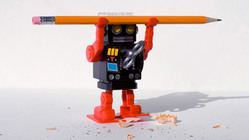
Adobe profiled and interviewed Big Medium’s Josh Clark about the opportunities and challenges for UX designers in a world of machine learning and artificial intelligence (AI). The design of data-driven interfaces is just as important as the underlying algorithms, Josh told Sheena Lyonnais, who wrote:
With an unprecedented amount of data being collected and algorithms driving many of our interactions, Clark says the challenge of what to with the data, how to present it, and how to use it to shape user behavior is now inherently a design question for today’s user experience designers.
“Typically digital designers have been creating interfaces for flows and for content for which we have complete control, and now we are gradually and slightly uncomfortably ceding some of that control to algorithms and digital models that we don’t quite understand—and that don’t quite understand us,” he said.…
“I think the really critical question we’re dealing with now in this early stage of artificial intelligence is how do we design the interfaces in ways that set appropriate expectations and channel user behaviors in ways that match the capabilities of the system?” Clark said. “When expectations are wrong or we ask the machines to do something they’re just not capable of, that’s frustrating, and sometimes damaging.”
Josh shared several insights in the interview:
- When machines generate the data and the interaction, the UX designer’s role is to anticipate and cushion the occasional weirdness, ambiguity and error that will emerge.
- Gathering good training data is a matter of good research. UX research techniques have to ramp up to match the unprecedented scale machine learning requires.
- Adding personality to data systems is the third rail of UX design. Too much may diminish the efficiency and utility that people expect of those systems.
- As data systems begin to understand visual symbols, AI could start to help designers rough out best-practice interfaces more quickly.
- AI is unlikely to replace the most creative parts of design and will instead be a useful “companion species” for more tactical production work.
- Designing great AI experiences requires both optimistic enthusiasm and skeptical critique as we integrate machine learning into the most fundamental parts of our society and culture.
Read the full interview at Adobe. For more, check out Josh’s long-form essay on the emerging role of design and AI: Design in the Era of the Algorithm.
Is your company wrestling with the UX of bots, data-generated interfaces, and artificial intelligence? Big Medium can help—with workshops, executive sessions, or a full-blown design engagement. Get in touch.





